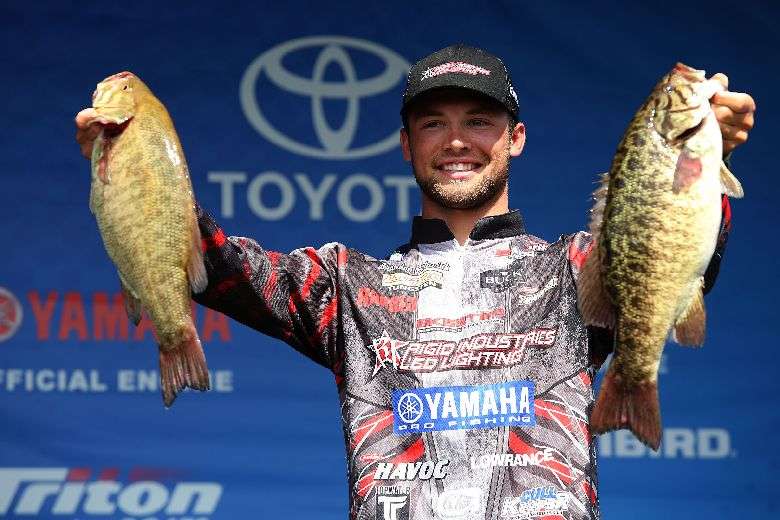
Given the chance to fish for smallmouth bass immediately before and after the spawn, it’s always a safe bet that Brandon Palaniuk will be slinging crankbaits.
During the pre-spawn, once the water temperature hits 42 degrees, he’ll be cranking, but mindful that colder water necessitates a slower retrieve. He’ll probe the 8- to 12-foot range with his Navionics chip looking for a defined contour line that runs from main wintering areas for smallmouth into spawning flats.
“Those fish are bunched up just before the spawning flat, waiting for the full moon and the water temperature to rise,” Palaniuk said. “From that spawning flat to that steeper bank, is a natural transition with bigger chunk rock mixed in with some pea gravel. They’ll gravitate to that bigger gravel. I like banks angled at 45 degrees that run out to 8 or 9 foot to a steep drop into 15 or 20.
“That’s primtime!”
During the spawn, when muddy water impairs his visibility, catching them cranking is key, especially on waters like his home lake of Couer d'Alene in Idaho. He said smallmouth will spawn in groups influenced by bottom composition.
“You’ll have a bay with harder patches of gravel, or a gravel patch and bigger boulders mixed in, and they’ll spawn right beside the boulders,” Palaniuk said. Upon hooking his first smallmouth, he’ll drop his Power Poles and methodically pick apart the area at a quick pace.
Following the spawn, Palaniuk believes many of the biggest smallmouth form “wolf packs,” grouping by size. Then they cruise shallow flats in search of crawdads and baitfish. Gravel flats mixed with smaller pea gravel and boulders in clear water are key.
On the Great Lakes and Green Bay, bigger smallmouth will roam the rock and grass edges of big shallow flats that fall into deeper water.
Palaniuk favors an Abu Garcia “Ike” Series Delay 7-foot, 3-inch medium-action rod and an Abu Garcia MGXtreme 7:1 baitcaster spooled with 12-pound Berkley Trilene 100 percent Fluorocarbon. While it seems a little quick for chasing cold-water smallmouth, there’s good cause.
“Smallmouth will hit a bait from behind and charge the boat,” Palaniuk said. “The gearing helps to pick up the slack and regain control over the fish.”
The smallmouth’s notorious acrobatics don’t concern Palaniuk. As they break the surface with their mouth open, he’ll run them from one end of the boat to the other, filling them with water and neutralizing their power.
“They’ll still fight,” he said, “but most often they don’t get the chance to jump as I have my rod tip in the water and I’ll pull them along.”
His approach includes four baits that he rotates through an area to make sure all fish get a taste of the menu.
Here’s a rundown of BP’s smallmouth cranking line-up:
Rapala Shad Rap RS7: It has a non-invasive action and suspends after deflecting off rocks, triggering bites. He prefers the crawdad color pattern.
Storm Arashi Deep 10: A self-correcting line-tie allows bait to deflect off the rocks and come back on track quicker than other baits. That makes it a key bait river and high-water conditions. He uses the rusty craw and red craw patterns.
Storm Wiggle Wart: He’ll match natural craw colors of the lake to his tackle box and use transparent colors on sunny days. His favorite colors are all of the craw patterns and the BPS exclusive colors.
Rapala DT10 or DT6: The baits offer bigger profiles with a fairly tight action. He will use DT10 in shallower water to dig the bottom on a slow retrieve. His favorite color pattern is “Ike’s Mule.”




